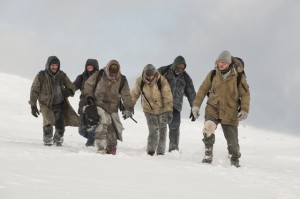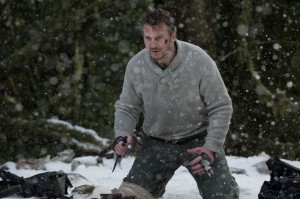Being stuck in harsh circumstances can either bring out the best or worst in man. And when the setting is the caustic climates and dreary landscape of Alaska, it’s likely to bring out a little of both. Add a hungry pack of wolves to the mix and it’s time for full on survivalism for those being hunted.
In The Grey, Ottway (Liam Neeson) leads a small group of men who have survived a plane crash through the Alaskan countryside. Unfortunately, it’s not just the elements that the men have to contend with as a pack of wolves begins to terrorize them as soon as the sun sets. Thankfully, Neeson’s character is an expert on wolves, seeing as his job is to use a sniper rifle to pick off any wolves that attempt to attack the oilers he works with.
As the men set up camp and try to figure out how they’re going to survive this ordeal, Ottway quickly takes charge of the group, confidently establishing his leadership skills and survival instincts. The hot-headed challenge of Diaz (Frank Grillo) not only tests the loyalties of the group, but also mirrors a similar power struggle happening between the nearby wolves, which is quickly put to rest when the alpha male bests his challenger. As The Grey progresses, the plights of the men continue to mirror the internal struggles of the wolf pack, setting up an interesting juxtaposition between man and beast.
Aside from its interesting philosophical perspectives, The Grey is a mixed bag of questionable continuity and impressive cinematography and dialogue. On the positive side, the plane crash scene is one of the most intense pieces of cinema ever recorded with its choppy effects and chaotic surrealism. The same can be said of the multiple dream sequences, in which people are whisked from euphoric serenity back to harsh reality with jolting clarity as they are assaulted by snow storms, the crashing plane and ravenous wolves. And after the plane crashes and the survivors regroup, The Grey, in many ways, turns into a horror movie as the monstrous wolves systematically and graphically pick men off one at a time.
But a few things left me with a big question mark over my head. For example, unless I missed something, there is never any mention of trying to use a cell phone to call for help. Granted, all the phones could have been lost or destroyed in the plane crash, and it’s highly likely that no one would have reception in such a desolate area. But one or two lines of dialogue explaining those things would have resolved these issues completely. Also, aren’t airplane liquor bottles typically made of plastic now? If so, why are the ones on this plane made of glass? Maybe I’m being a bit nitpicky, but in a movie that otherwise seems hyper-realistic, these minor flaws become almost as jarring as the circumstances the men are facing.
The Grey‘s climax is also a bit odd, as the alpha male from each tribe squares off for one final battle. It’s established earlier in the film that Ottway has little motivation to keep on living, so his willingness to stand and fight (and probably die) is no surprise. But even with the post-credit snippet that vaguely shows the result of the conflict, the viewer is left not knowing what the true outcome is.
These minor gripes aside, The Grey is an intense look at how man reacts when faced with the forces of nature. And even though the wolves are given an almost supernatural mystique, the similarities between man and animal reveal a few things about human nature that we don’t often take the time to consider.


